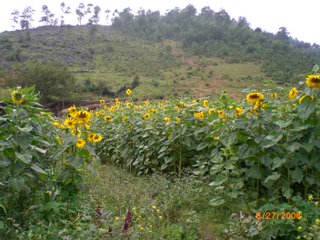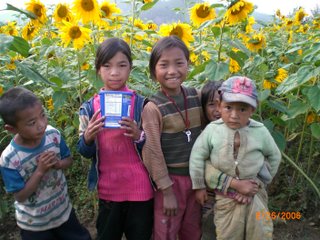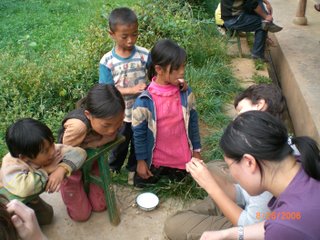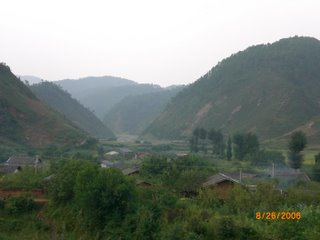onward from yanyuan to yangjuan
The last time I blogged...I left with you all the picture of the cook making knife-cut noodles. I found the website that I used to learn some Yi back when I was still in Seattle. Here is a sample of their writing:
*i'm hoping this will show up...I had to download a program for this earlier...so it may not show up*
ꐋꀨ,ꆏꇿꄉꇁ?
Remember what I wrote in my last blog? Well...this is the writing for "Friend, where are you from." The pin ying for this is: qop bop, ne kat da la?
Different isn't it? One of the differences between the Nuosu language and Mandarin is that the Nuosu language uses characterization much like English. You have designated letters for each type of pronounciation. I asked my friend/interpreter while I was Yangjuan how many of these characters they had and she said there were 891.
August 26, 2006
As we continued on by road to Yangjuan, the roads were made from dirt rather than being cemented over. So...the last few hours of our journey were rather bumpy. However, the scenary was absolutely breathtaking. Just this year, Nuosu villagers began planting sunflowers as a cash crop. This new addition brilliantly painted the landscape with greens and yellows.
 When we arrived, we were greeted by ꀉꁌ (ax pu) and the Ma family. They warmly welcomed us to the school and we got settled in. Steve had a meeting with some of the people at Yangjuan, so we hung out with the Nuosu kids. You can't but just love them. They open their hearts out to you despite the language barrier. I have always felt that children have a way of communicating with you without the need for actual words. Some of the kids, though, could speak Mandarin. Others, though, couldn't at all. Either way, we followed a group of kids around to the nearby bridge and through a sunflower patch. Never having had the experience of walking through 7 feet high sunflowers, it was really something. The kids often run around the fields and play in the stream eating freshly picked apples and sunflower seeds. This was also the first time I have ever had unbaked sunflower seeds. They were nothing like I expected - better. I took several pictures of the kids - both in the fields as well as at the school. Here are some of the kids we met:
When we arrived, we were greeted by ꀉꁌ (ax pu) and the Ma family. They warmly welcomed us to the school and we got settled in. Steve had a meeting with some of the people at Yangjuan, so we hung out with the Nuosu kids. You can't but just love them. They open their hearts out to you despite the language barrier. I have always felt that children have a way of communicating with you without the need for actual words. Some of the kids, though, could speak Mandarin. Others, though, couldn't at all. Either way, we followed a group of kids around to the nearby bridge and through a sunflower patch. Never having had the experience of walking through 7 feet high sunflowers, it was really something. The kids often run around the fields and play in the stream eating freshly picked apples and sunflower seeds. This was also the first time I have ever had unbaked sunflower seeds. They were nothing like I expected - better. I took several pictures of the kids - both in the fields as well as at the school. Here are some of the kids we met:  I could'nt catch all of their names...but I did get the names of the two right-most girls in this picture. The one in the center is Ni Vu Zhri. Ma Chu Ge is the little girl holding up her little brother. They were rather shy at first...but candy always has a way to coerce kids to open up. Sara brought Vita-balls from the states. Soon, all of us UW students joined the kids in blowing gum bubbles. In exchange for candy, they gave us walnuts. We had a bit of trouble cracking these nuts open...but they were nothing for the kids. What you have to do is hold the walnut in the palm of your hand. Then, taking care not to smash your fingers, whack the nut into the ground until it cracks. Be sure to take off the outter most peel of the edible part of the nut. If you don't, the nut will taste really bitter. It took quite a bit of tries before we got it. The kids? They were pros.
I could'nt catch all of their names...but I did get the names of the two right-most girls in this picture. The one in the center is Ni Vu Zhri. Ma Chu Ge is the little girl holding up her little brother. They were rather shy at first...but candy always has a way to coerce kids to open up. Sara brought Vita-balls from the states. Soon, all of us UW students joined the kids in blowing gum bubbles. In exchange for candy, they gave us walnuts. We had a bit of trouble cracking these nuts open...but they were nothing for the kids. What you have to do is hold the walnut in the palm of your hand. Then, taking care not to smash your fingers, whack the nut into the ground until it cracks. Be sure to take off the outter most peel of the edible part of the nut. If you don't, the nut will taste really bitter. It took quite a bit of tries before we got it. The kids? They were pros. Later that evening, we played basketball with the local boys. It was Sarah, Sara, Matt, Alex, and me against 5 Nuosu boys. Did we get owned or what! We played until we couldn't see the ball anymore. This was about the time when I felt breathless. The altitude in Yangjuan is alot higher than it is in Chengdu. Running across the court was hard work. Before going to bed that night, I learned a new card game: Hearts. We played several rounds before heading on to bed: girls in one room, boys in another.
Later that evening, we played basketball with the local boys. It was Sarah, Sara, Matt, Alex, and me against 5 Nuosu boys. Did we get owned or what! We played until we couldn't see the ball anymore. This was about the time when I felt breathless. The altitude in Yangjuan is alot higher than it is in Chengdu. Running across the court was hard work. Before going to bed that night, I learned a new card game: Hearts. We played several rounds before heading on to bed: girls in one room, boys in another.August 27, 2006
This morning, we got up around 8:30 AM and had a breakfast of hard boiled eggs, a sort of Nuosu pancake, and congee. Soon after, the five of us went our separate routes, Alex and Sarah to seek out interviewees regarding hua jiao or flower pepper, Matt to catch frogs, and Steve, Sara, and I to 偏水 (Piang Shui). This was another Nuosu village near Yanjuan, only about a 15-20 minute walk from the elementary school we were staying at. Today, we were seeking out Er Ga Ga, the bimo in that area. I'm not sure everyone knows this yet, but my research in Yangjuan concerns the impact the Cultural Revolution had on the ethnic minority. In particular, I am interested in investigating how the CR altered people's belief system. What's so important about the bimo? Well...he is the clergy/healer/historian of the Nuosu people. I feel that by understanding how people view the bimo, I can begin to unveil the influence the CR had on the people in Yanjuan. There's still alot more to my research...and if anyone is interested...they can read my research proposal. It's fairly lengthy...but if anyone is interested...I can post it. Anyways, when we arrived at Er Ga Ga's place, we were welcomed into his home and given a cha er wa (a sheep-hair woven cloak worn my sheep herders during colder days) to sit on. Er Ga Ga was in the midst of brewing Tibetan tea when we arrived. Tibetan tea is a concoction of butter, hot water, and salt. When brewed, it has a color similar to that of chai or English breakfast tea with milk. The taste? Different. It has a strong, nutty taste to it.
Er Ga Ga is 64 years old and the only bimo in 偏水. His health hasn't been too well for the past year...and his vision had also started to deterioate. Steve brought him some vitamins, medicine, and tea. We didn't stay very long...but we did get to introductions. He was heading to Yanyuan tonight...when he comes back, he'll be willing to be interviewed. This place is unbelieveable. It seems so surreal to be in this place after three years of planning...but, here i am!



0 Comments:
Post a Comment
<< Home